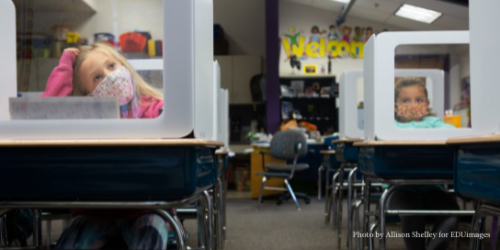Stories of exacerbated teacher shortages are dominating both local and national education headlines. It’s an easy story to believe, given the stress and uncertainty teachers have faced during the pandemic, on top of longstanding challenges like low pay. As industries have struggled to meet demand for new employees and professions have been swept up in ‘the Great Resignation,‘ has teaching experienced similar disruptions?
Here we use the most recent data and reporting to paint a picture of what we do and do not yet know about teacher supply and demand during the pandemic era.
Dire warnings of a national teacher shortage have abounded for years, despite weak evidence that a general shortage exists. At the same time, these warnings have done little to address well-documented chronic shortages in certain subject areas (e.g., STEM, special education, and ELL education) and locations (such as rural and low-income urban schools), suggesting, in the words of EdCounsel’s Sandi Jacobs, “either a lack of effective solutions or a lack of will to improve teacher supply in these areas.”
In spite of concerns that difficult teaching conditions would cause a wave of teachers to quit during the pandemic, national jobs data suggests these resignations have not come to pass at any point, at least in the national aggregate. Teacher quit rates early in the pandemic held at lower or average numbers compared to previous years, and in spite of renewed concern during the transition to a new school year, have also remained consistent in recent months.
Public education job openings and hiring tracked by the Bureau of Labor Statistics (BLS) have both risen sharply in 2021, and openings have stubbornly outpaced hiring, leading to a high overall vacancy rate. Edunomics Lab’s Chad Aldeman recently speculated this gap is likely due to a combination of unfilled positions from the year prior and new roles funded by stimulus dollars. Notably, BLS data only tracks trends in public education jobs overall, including roles that have faced acute shortages this year, such as substitute teachers, cafeteria staff, bus drivers, and para-professionals.
This large pool considerably limits how much BLS data can tell us about teachers specifically. Nationwide data on teachers alone remains woefully thin, but some national survey data can give us an idea of the broad picture. In the summer of 2021, a national survey of district leaders by the RAND Corporation found that district leaders reported that 6% of their teachers resigned or retired at the end of the 2020-2021 school year, a comparable figure to their pre-pandemic turnover rates.
Yet at the same time, recent analysis of 20 districts by Chalkbeat found that the majority were facing sizable teaching vacancies. Several district leaders interviewed for the piece gave differing accounts of where their vacancies came from, with some noting turnover and others citing an influx of new hiring due to stimulus funds. That meant that except for a few instances, Chalkbeat’s analysis wasn’t able to determine the extent to which the vacancy rates in the districts they analyzed were driven by a wave of resignations, expanded hiring, or chronic and persistent vacancies.
Absent more districts collecting and publishing detailed data on the nature of their vacancy rates, there is no evidence of large-scale resignations among teachers. And given informed predictions that, where they do occur, teacher shortages will hurt schools serving low-income students and students of color more, having this data is particularly urgent.
If nothing else, the lack of available evidence should caution policymakers and education leaders away from one-size-fits-all solutions generally offered to address a broader teacher shortage, but few of which will fix the persistent shortages almost all districts experience. Districts need to analyze their own local data at the most granular level to understand where and how to target resources. As forthcoming data from NCTQ will show, far too few districts and states arm themselves with the necessary data to understand the ebbs and flows in their own local labor markets. This leaves leaders unable to answer important questions like: Where are we experiencing new or chronic teacher shortages? Have we lost a disproportionate number of teachers this year, and if so, who are they?
Teachers’ self-reported plans to leave their role or the profession have also generated a great deal of concern about a looming wave of resignations and retirements. For example, in a separate survey of teachers conducted by the RAND Corporation in the winter of the 2020-2021 school year, one in four teachers reported that they intended to quit. To date, there is no evidence that teachers followed through on this intention at nearly the scale of one in four.
This is far from reassurance that all is well in the profession. In the same RAND survey, teachers reported troublingly high rates of job-related stress and symptoms of depression, above those of the general adult population.
Regardless of how teacher burnout, stress, and job satisfaction impact staffing in the short term, acknowledging and addressing these concerns is vital to the health of the profession, and to the wellbeing and academic success of students over the long haul. A recent meta-analysis found that burnout is one of the top two risk factors that predict a teacher’s likelihood of quitting, and a number of studies have also linked lower teacher mental health to decreases in instructional effectiveness, and negative impacts on students’ mental health and academic success.
RAND’s data may also point to solutions that are relevant to the pandemic era: self-reported stress, burnout, difficulty coping, and depressive symptoms all had strong correlations with common conditions of pandemic teaching. Lack of social distancing in classrooms, for instance, was strongly linked to increases in all of the symptoms listed above, as were experiencing lack of support from administrators or reporting consistent technology issues during remote instruction.
Only time (and better data) will tell how these turbulent and difficult years impact our current teacher workforce. In the short term, education leaders would do well to focus on better understanding their own teacher supply and demand data and responding to the challenges that their current workforce is experiencing.
More like this

Leave and health insurance for teachers: safeguards amid COVID-19 worries
In the absence of a federal protection, it becomes the jurisdiction of individual districts to lay out protocols.

